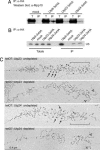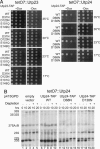The PINc domain protein Utp24, a putative nuclease, is required for the early cleavage steps in 18S rRNA maturation
- PMID: 16769905
- PMCID: PMC1480430
- DOI: 10.1073/pnas.0603673103
The PINc domain protein Utp24, a putative nuclease, is required for the early cleavage steps in 18S rRNA maturation
Abstract
Ribosome biogenesis is a complex process that requires >150 transacting factors, many of which form macromolecular assemblies as big and complex as the ribosome itself. One of those complexes, the SSU processome, is required for pre-18S rRNA maturation. Although many of its components have been identified, the endonucleases that cleave the pre-18S rRNA have remained mysterious. Here we examine the role of four previously uncharacterized PINc domain proteins, which are predicted to function as nucleases, in yeast ribosome biogenesis. We also included Utp23, a protein homologous to the PINc domain protein Utp24, in our analysis. Our results demonstrate that Utp23 and Utp24 are essential nucleolar proteins and previously undescribed components of the SSU processome. In that sense, both Utp23 and Utp24 are required for the first three cleavage steps in 18S rRNA maturation. In addition, single-point mutations in the conserved putative active site of Utp24 but not Utp23 abrogate its function in ribosome biogenesis. Our results suggest that Utp24 might be the elusive endonuclease that cleaves the pre-rRNA at sites A(1) and/or A(2.).
Conflict of interest statement
Conflict of interest statement: No conflicts declared.
Figures






Similar articles
-
hUTP24 is essential for processing of the human rRNA precursor at site A1, but not at site A0.RNA Biol. 2015;12(9):1010-29. doi: 10.1080/15476286.2015.1073437. RNA Biol. 2015. PMID: 26237581 Free PMC article.
-
Structural and functional analysis of Utp24, an endonuclease for processing 18S ribosomal RNA.PLoS One. 2018 Apr 11;13(4):e0195723. doi: 10.1371/journal.pone.0195723. eCollection 2018. PLoS One. 2018. PMID: 29641590 Free PMC article.
-
Structural and functional analysis of Utp23, a yeast ribosome synthesis factor with degenerate PIN domain.RNA. 2013 Dec;19(12):1815-24. doi: 10.1261/rna.040808.113. Epub 2013 Oct 23. RNA. 2013. PMID: 24152547 Free PMC article.
-
snR30/U17 Small Nucleolar Ribonucleoprotein: A Critical Player during Ribosome Biogenesis.Cells. 2020 Sep 29;9(10):2195. doi: 10.3390/cells9102195. Cells. 2020. PMID: 33003357 Free PMC article. Review.
-
Human diseases of the SSU processome.Biochim Biophys Acta. 2014 Jun;1842(6):758-64. doi: 10.1016/j.bbadis.2013.11.004. Epub 2013 Nov 12. Biochim Biophys Acta. 2014. PMID: 24240090 Free PMC article. Review.
Cited by
-
The DEAD-box RNA helicase-like Utp25 is an SSU processome component.RNA. 2010 Nov;16(11):2156-69. doi: 10.1261/rna.2359810. Epub 2010 Sep 30. RNA. 2010. PMID: 20884785 Free PMC article.
-
"PP2C7s", Genes Most Highly Elaborated in Photosynthetic Organisms, Reveal the Bacterial Origin and Stepwise Evolution of PPM/PP2C Protein Phosphatases.PLoS One. 2015 Aug 4;10(8):e0132863. doi: 10.1371/journal.pone.0132863. eCollection 2015. PLoS One. 2015. PMID: 26241330 Free PMC article.
-
Utp23p is required for dissociation of snR30 small nucleolar RNP from preribosomal particles.Nucleic Acids Res. 2012 Apr;40(8):3641-52. doi: 10.1093/nar/gkr1213. Epub 2011 Dec 17. Nucleic Acids Res. 2012. PMID: 22180534 Free PMC article.
-
Synergistic defects in pre-rRNA processing from mutations in the U3-specific protein Rrp9 and U3 snoRNA.Nucleic Acids Res. 2020 Apr 17;48(7):3848-3868. doi: 10.1093/nar/gkaa066. Nucleic Acids Res. 2020. PMID: 31996908 Free PMC article.
-
Nob1 binds the single-stranded cleavage site D at the 3'-end of 18S rRNA with its PIN domain.Proc Natl Acad Sci U S A. 2009 Aug 25;106(34):14259-64. doi: 10.1073/pnas.0905403106. Epub 2009 Aug 14. Proc Natl Acad Sci U S A. 2009. PMID: 19706509 Free PMC article.
References
-
- Grandi P., Rybin V., Bassler J., Petfalski E., Strauss D., Marzioch M., Schafer T., Kuster B., Tschochner H., Tollervey D., et al. Mol. Cell. 2002;10:105–115. - PubMed
-
- Osheim Y. N., French S. L., Keck K. M., Champion E. A., Spasov K., Dragon F., Baserga S. J., Beyer A. L. Mol. Cell. 2004;16:943–954. - PubMed
Publication types
MeSH terms
Substances
Grants and funding
LinkOut - more resources
Full Text Sources
Molecular Biology Databases

